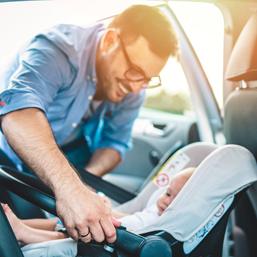
As an advocate for car seat safety and a recently trained Child Passenger Safety Technician (CPST), I was honored to be chosen by the Government of Alberta to help parents keep our littlest Albertans safe on the road. You can keep your little ones safe by learning the law and current best practices.
Alberta Motor Vehicle Law
Alberta law requires that all occupants travelling in a motor vehicle use a seat belt or child safety device that is properly worn and adjusted. The fine for not using a seat belt or a child safety seat is $155. It is the driver’s responsibility to ensure that all passengers under 16 years of age are in an appropriate child restraint or are using their seat belt correctly - failure to do so can result in a fine for each unrestrained passenger. All children under 18 kilograms (40 pounds) or under the age of six must use an appropriate child restraint in a motor vehicle.
Respecting the law means following your child restraint and vehicle manuals
Just because your child is wearing a seat belt or is strapped into a seat doesn’t mean you are respecting the law. Alberta law stipulates proper use. All car seats have age, weight, and height requirements, as well as specifications for correct installation and usage. All motor vehicles stipulate the correct fit for a seat belt, in the absence of which a child should use a booster. All vehicle user manuals and safety labels warn that passengers under the age of 13 should always ride in the back seat.
Stage 1: Rear-facing seats. Rear-facing seats should be used at a minimum until a child is one and at least 10 kilograms (22 pounds); this is the bare minimum. Many child restraint manufacturers have stricter requirements, including an age minimum of two years and higher weight minimums. There is no reason to ‘graduate’ your child from a rear-facing seat to a forward-facing seat because they turn one; riding rear-facing provides extra protection and having their legs bent in front of them does not put them at risk.
CPSTs and the American Pediatric Association recommend that children ride rear-facing until at least age two, and you can continue to rear-face your child until they have outgrown the height and weight limits of their rear-facing seat.
Stage 2: Forward-facing seats. Forward-facing seats with a five-point harness can be used until your child reaches the height or weight maximum set out by the manufacturer. The maximum weight for seats sold in Canada is 29 kilograms (65 pounds) but check your specific seat as some have lower limits. Remember, you are required by law to tether your forward-facing seats in your vehicle.
Your child should remain in their forward-facing seat until they are at least 18 kilograms (40 pounds) and have reached the maturity level required for using a booster seat (typically in the range of five- to seven-years-old).
Stage 3: Booster seats. Booster seats ensure the adult seat belt is positioned over the strongest bones in a child’s body; the lap belt lies across the hips rather than the soft and vulnerable abdomen, and the shoulder belt lies across the chest, preventing the upper body from moving forward on impact.
The most important factor in deciding to put your child in a booster seat - once the height, weight, and age minimums of the chosen seat are met - is their maturity. Remember the part of Alberta law that stipulates “properly worn and adjusted”? A booster seat’s job is to make sure the seat belt is properly worn and adjusted on children too small to use the vehicle seat belt alone. But this also requires the cooperation of the child. Although many booster seats on the market specify an age minimum of four, the Government of Alberta and CPSTs recommend booster seats for children six and up. This is because the child must be responsible enough to sit properly in their booster seat for the entire ride: no leaning forward, no reaching down to the floor, no tucking their shoulder belt behind them, no randomly deciding to unbuckle the booster seat.
A great tip for helping your reluctant older child accept a booster seat is to choose a seat that transforms from a high-back booster to a low-back booster. Hopefully, when your child starts to feel ‘too old’ for a car seat, transforming their seat into a more subtle, low-back booster will help. There are also discreet low-back boosters on the market designed to keep bigger kids safe and happy.
Stage 4: Adult seat belt. The key to deciding if a child can sit safely with an adult seat belt is not so much age, but size. The child needs to fit the adult seat belt in order to be protected.
Proper seat belt fit is assessed with these criteria:
Children are typically between the ages of nine and 11 when they fit an adult seat belt properly, but this will vary greatly from child to child and at times, vehicle to vehicle.
Using a child restraint or a seat belt correctly saves lives:
If you have questions about your child restraints, don’t hesitate to reach out to a CPST certified by the Child Passenger Safety Association of Canada.
Lindsay is a certified Child Passenger Safety Technician and provides in-person installation and education sessions, car seat test fittings, seminars, and more. Learn more at carseatcubs.ca. Service disponible en Français.
Calgary’s Child Magazine © 2024 Calgary’s Child